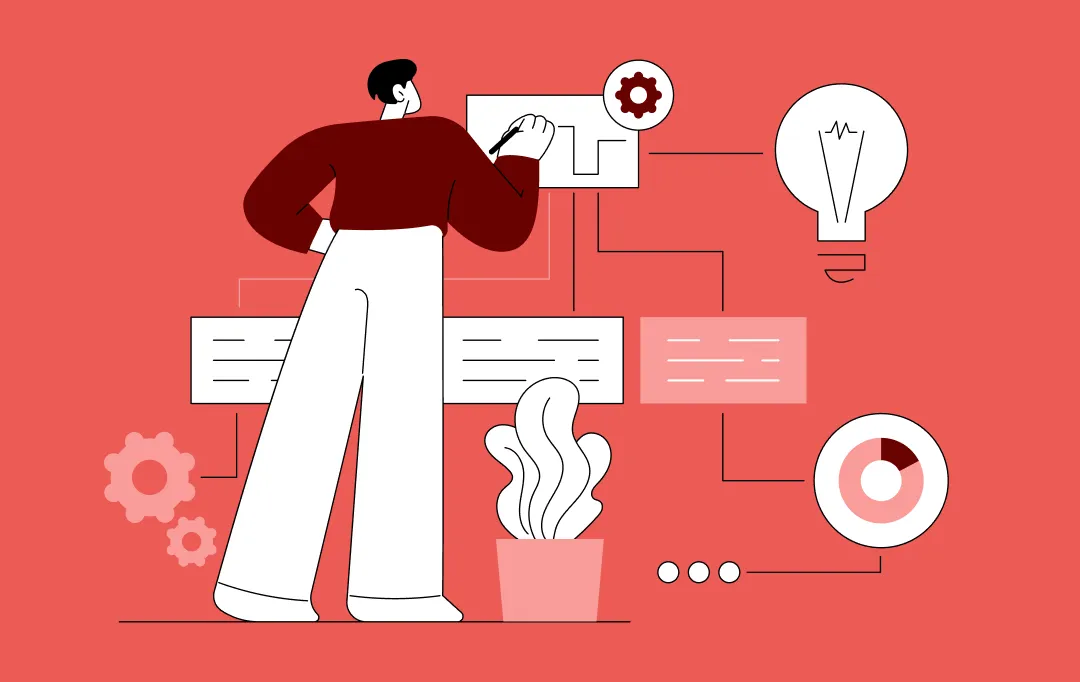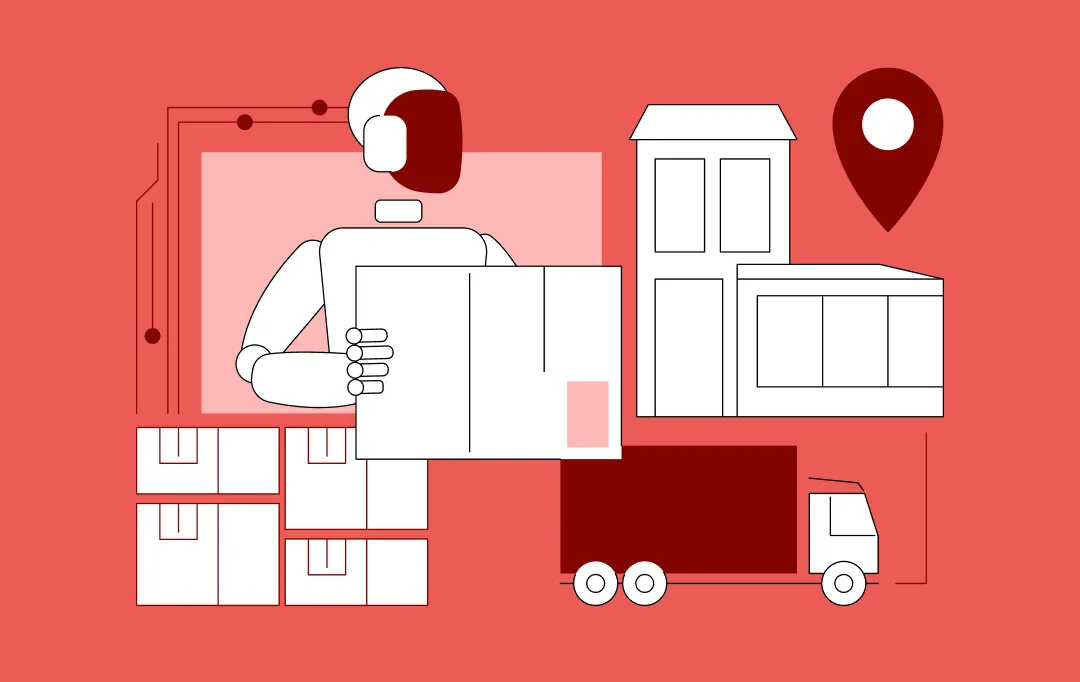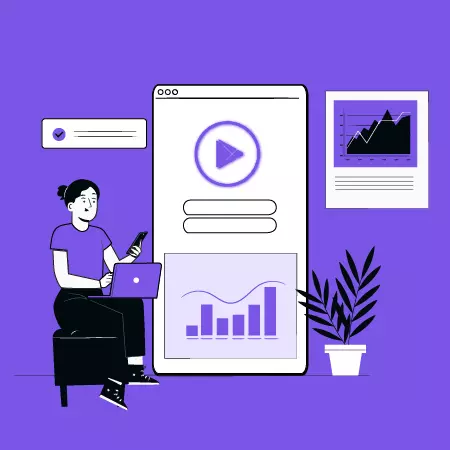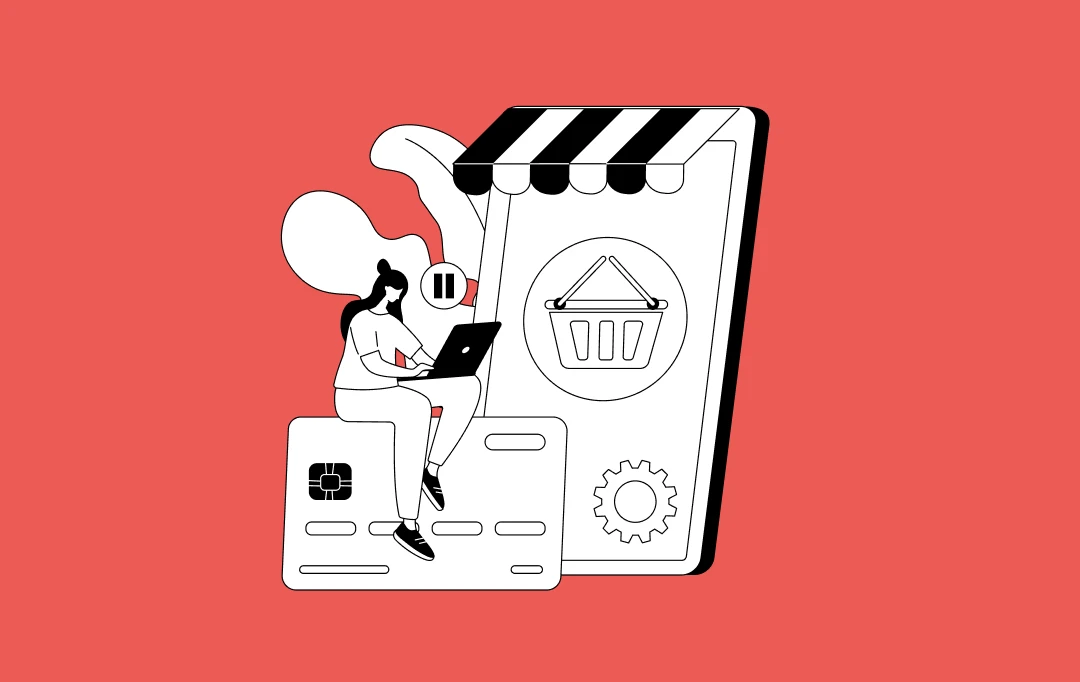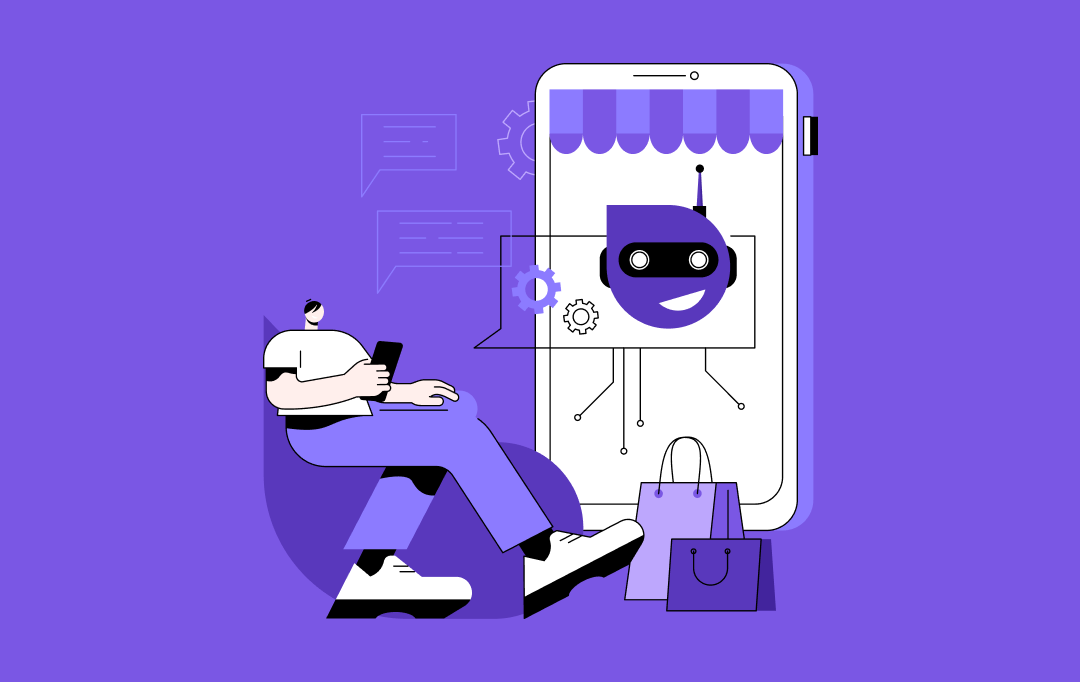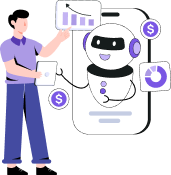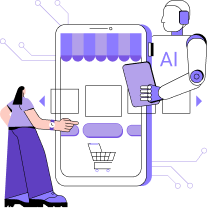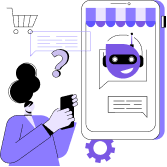- Define Your AI Marketplace Vision and Strategy
- Clarify Your Value Proposition
- Identify the Two Sides of Your Network
- Pinpoint Where AI Adds Value
- Connect AI to Business Outcomes
- Research the Market and Build a Data Strategy
- Competitive Mapping
- Demand Validation
- Data Sourcing
- Compliance Prep
- Design the Right Architecture and Technology Stack
- Backend & Core Infrastructure
- AI & Machine Learning Layer
- Frontend
- Integrations and Security
- Build the Core Feature Set and AI Differentiators
- AI-Powered Enhancements
- Start Lean but Create an “Aha Moment”
- Phases of AI Marketplace App Development
- Planning & Requirements
- UX/UI Prototyping
- Model Development & Integration
- Backend and Frontend Development
- QA & Testing
- Deployment & Monitoring
- Post-Launch Improvement
- Understanding Cost and Timelines of AI Marketplace App Development
- What Drives the Cost
- Typical Cost Ranges
- Plan for Ongoing Spending
- Go-to-Market & Growth Tactics
- Early Liquidity
- AI-Powered Onboarding
- Feedback Loops
- Positioning and Storytelling
- Challenges and Best Practices for AI Marketplace Apps
- Cold Start Problem
- Bias in AI Models
- Data Privacy Concerns
- Rising AI and Infrastructure Costs
- Why Partnering with Appinventiv Accelerates Your AI Marketplace Vision
- FAQs
Key takeaways:
- An AI marketplace should feel alive, not just be a place to post and browse. It can learn what people like, keep transactions safe, and make buying or selling feel effortless.
- The quality of your AI comes from the quality of your data. Think early about how you’ll gather, clean, and protect it so people trust your platform from day one.
- Start simple but strong. Launch the core features first, then add one or two smart AI touches that truly impress people.
- Costs can vary a lot. A small AI MVP might begin around $40k, while complex builds can go beyond $400k. Plan for updates and AI training after launch.
- Growth takes intention. Give early users a reason to join, make sign-up effortless, and show why your platform is safer and smarter.
Online marketplaces are changing quickly. What once worked as simple listing sites is turning into something smarter. These platforms now match users faster, personalize what they see, and keep transactions safe with automation. McKinsey’s State of AI report shows that more than 75% of organizations now use AI in at least one part of their business, proof that what used to feel experimental is now part of everyday operations in many industries.
For founders and product leaders, there’s a clear chance to move past crowded, static marketplaces and build something smarter. When you build an AI-powered marketplace app, you are not just helping people trade; you are shaping a platform that learns, adapts and keeps users coming back. AI can study behavior to suggest what the buyer wants next, identify risky behavior before it ruins the trust, reduce the work of moderation, even anticipate pricing and demand patterns.
But creating a platform like this is more than adding an AI tool. It means making deliberate choices about data, privacy rules, technology and when to launch. This guide walks you through what it takes to build an AI-powered marketplace app that stands out and grows in a competitive market.
Make your marketplace stand out by building an AI-powered app today.
Define Your AI Marketplace Vision and Strategy
Before you jump into design or code, spend time shaping what your marketplace will actually stand for. This is the first and most important step in AI marketplace app development, making sure your product solves a clear problem. This is where you decide what gap you’re filling and how AI will make the experience feel smarter than anything out there.
Clarify Your Value Proposition
Be specific about the problem you’re solving. Maybe it’s helping people find the right product faster, connecting skilled professionals to paying clients, renting out things that usually sit idle, or opening up a niche B2B exchange. Each space has its own friction.
Think about where users struggle today:
- Are buyers stuck scrolling through endless options?
- Do sellers waste time proving they’re legitimate or guessing the right price?
The answers here will shape the heartbeat of your app, the one reason people come back instead of bouncing to a bigger but less focused platform.
You see a similar pattern in hyperlocal delivery business models, where one focused promise, such as reliable one hour delivery, makes the platform worth returning to.
Identify the Two Sides of Your Network
Every marketplace is a balancing act. You’ve got buyers and sellers, seekers and providers — each with different expectations. AI can help you keep both sides happy, but you need to know which one to win over first.
- For buyers: make it easy to find what they want, trust who they’re buying from, and feel safe paying.
- For sellers: bring the right customers, fair pricing cues, and insights to improve sales.
Knowing who you’re serving first also shapes early marketing and feature priorities.
Pinpoint Where AI Adds Value
AI shouldn’t just be a shiny label; it has to make life simpler for users. A few ways it can do that:
- Smart recommendations & discovery: Show items or services people are actually looking for, without them digging.
- Natural language search: Let users type the way they think: “freelance UX designer in London with healthcare experience.”
- Fraud detection and trust scoring: Quietly screen out fake or risky accounts so buyers and sellers feel safe.
- Dynamic pricing: Help sellers price confidently by analyzing demand and similar listings.
- AI chat support and onboarding: Answer common questions, guide new users as they sign up, and help reduce early drop-offs.
- Review and sentiment analysis: Scan feedback quickly to highlight reliable sellers and surface trending products.
These examples show the growing role of AI in marketplace apps, helping platforms deliver speed, personalization, and trust.
Connect AI to Business Outcomes
Every smart feature should have a business reason behind it:
- Recommendations – more repeat buyers and bigger orders.
- Fraud detection – fewer chargebacks and angry support calls.
- Dynamic pricing – better seller success and platform commissions.
- AI onboarding – faster user activation and long-term retention.
These direct business outcomes make the benefits of an AI marketplace app clear to investors, early users, and your own team.
Framing your AI choices around clear goals helps you avoid building features that look impressive but don’t drive growth. It also gives you a story to tell investors, team members, and early adopters about why your marketplace is worth their trust.
Research the Market and Build a Data Strategy
Once you know what your marketplace should do, stop and test the idea before writing a single line of code. See if the market is ready and think about the data you’ll need. Skipping this step is why many platforms fail — they either solve nothing or launch with AI that doesn’t work well because the data behind it is poor.
Competitive Mapping
Start with a reality check. Look at the marketplaces already working in your space, from the big names everyone knows to smaller AI-driven ones that might be doing something smart. Dig into their features, how they price, how their sites feel to use, and what people complain about in reviews or forums.
Ask simple questions:
- Where do customers still get frustrated?
- Is personalization weak or missing?
- Are competitors using AI only for search and ignoring trust, pricing, or recommendations?
Keep notes. Even a simple table of gaps and frustrations will show you where your marketplace can stand out and where to bring in AI-based marketplace solutions that actually solve pain points.
Demand Validation
Do not build blind. Test interest early:
- Talk to potential users. Short calls or quick surveys can reveal what’s missing for them and what would make them switch.
- Try a basic landing page. Write a short pitch, add an email sign-up, maybe run a small ad to see if people click.
- Show a simple demo. Even clickable mock-ups can tell you if the idea feels useful or not.
These small moves cost little but give real proof that it’s worth moving forward to build an AI marketplace platform.
Data Sourcing
AI is only as good as the data it learns from. Plan this early so you are not stuck fixing bad data later:
- User logs: Tack searches, clicks, and purchases to train recommendations and fraud checks.
- Public datasets: Use open product catalogs or review sets to jump-start the AI.
- Partner APIs: Pull in extra signals like payments, shipping info, or identity checks.
- Manual labeling: Sometimes people need to tag examples, like safe versus risky transactions.
Thinking this through now makes future on-demand marketplace AI integration easier and more affordable. Clean data from day one means better AI and a marketplace people can trust.
Compliance Prep
Privacy builds trust. If you are handling personal information, you need to follow rules like GDPR and CCPA:
- Be open about what you collect and why.
- Only keep what is essential.
- Mask or anonymize personal details wherever you can.
- Make consent simple and clear.
Getting privacy right can also be a selling point. Users are more likely to try a new platform if they feel safe.
Design the Right Architecture and Technology Stack
The technology decisions you make here will define the long-term success of your AI-powered marketplace app development journey. Once you know what your marketplace should do, think about how to build it so it grows without breaking. This is where you set the foundation. The right setup now saves you from expensive rebuilds later.
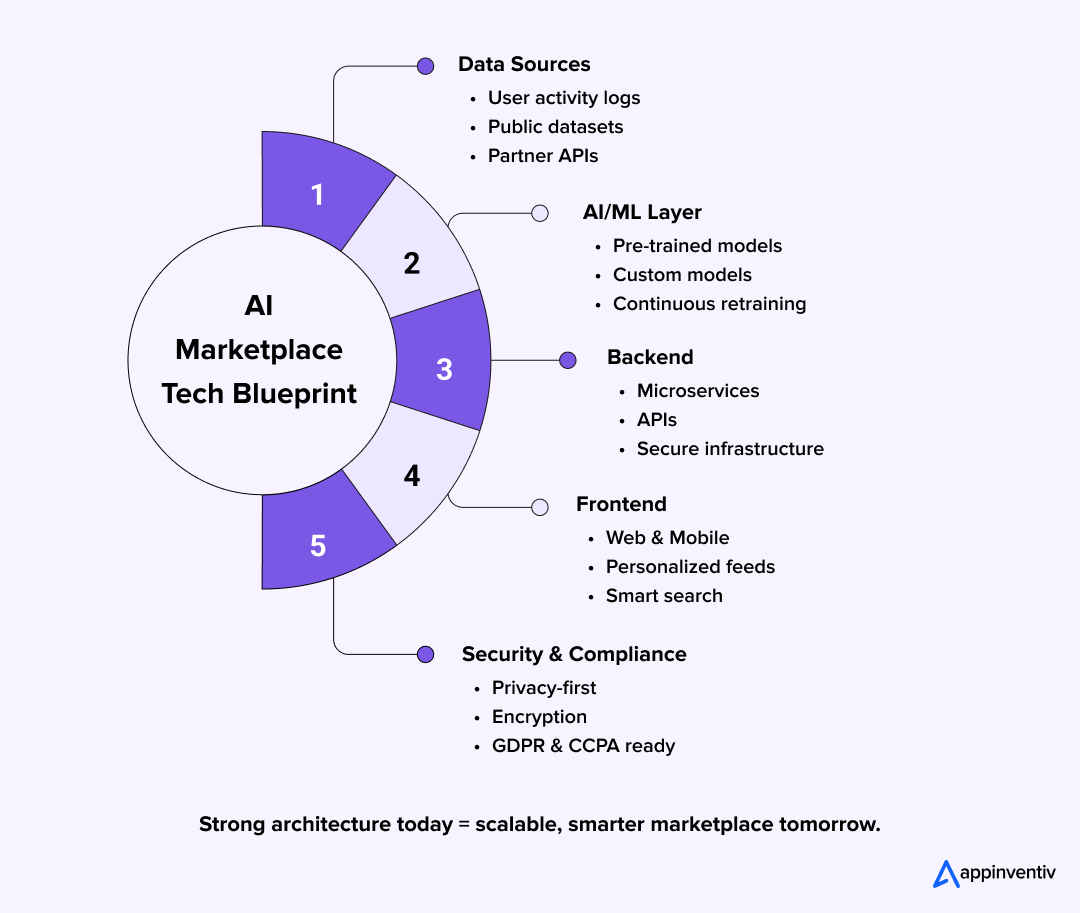
Backend & Core Infrastructure
Your backend is the engine of the platform. If you expect fast growth, consider a microservices setup. Breaking the app into parts such as user accounts, search, payments and recommendations keeps one busy area from slowing everything else down.
If you are testing an early idea, it is fine to start simple with a single backend. It is quicker and cheaper to launch, and you can move to microservices when the user base expands.
No matter the size, spend time on strong, well documented APIs. They will power your mobile and web apps and make future AI integrations easier. This is also the stage where you start planning for the AI-driven platform development for marketplaces so it can scale and handle smarter features over time.
AI & Machine Learning Layer
This is where your marketplace starts to feel smart. To move fast at first, use pre-trained models for things like recommendations or fraud checks. They let you prove the concept without big data science costs.
McKinsey research suggests that generative AI could add between $240 billion and $390 billion in value every year for retail platforms, mainly by making recommendations sharper and catching fraud early. For anyone planning AI-driven marketplace platform development, that is a clear sign of the ROI potential.
When your app grows or you need something very specific, like matching rare skills or pricing unique goods, start training custom models with your own data. This is often the point where teams move toward custom AI marketplace app development to tailor algorithms and workflows to their unique audience.
Plan early for:
- How you will run the models so results show up instantly when someone searches or browses.
- How you will keep the models fresh by retraining them as your data grows.
Frontend
The frontend is what people see and use. Build where your audience is, web, mobile, or both. React or Vue work well for web, while React Native, Flutter, or native iOS/Android are strong for mobile.
Keep the design flexible. AI-driven elements like personalized feeds or predictive search will evolve. Your interface should adapt without needing a full redesign each time. It also helps to look for simple ways to reduce app frontend maintenance cost so updates stay manageable as your marketplace grows.
Integrations and Security
Think early about the tools your marketplace will need to run well. Outside services will power a lot of what you build. Plan for how things like fraud checks, chat support and recommendations will work with payments, identity checks and analytics.
Some key areas to cover:
- Payments so people can buy and sell safely.
- Identity checks to make sure users are real and trustworthy.
- Messaging and notifications so buyers and sellers can talk and stay engaged.
- Analytics so you know what is working and where users drop off.
Security should be part of the plan from the start. Protect personal data with encryption, give your team only the access they need and watch for suspicious activity before it becomes a problem. The choices you make here will affect cost too. A well planned setup makes it easier and cheaper to add AI features later.
Build the Core Feature Set and AI Differentiators
Get the basics right before you think about advanced AI. People should be able to join easily, find what they want and feel safe paying. Once the essentials are strong, AI can make the experience smarter and keep users coming back.
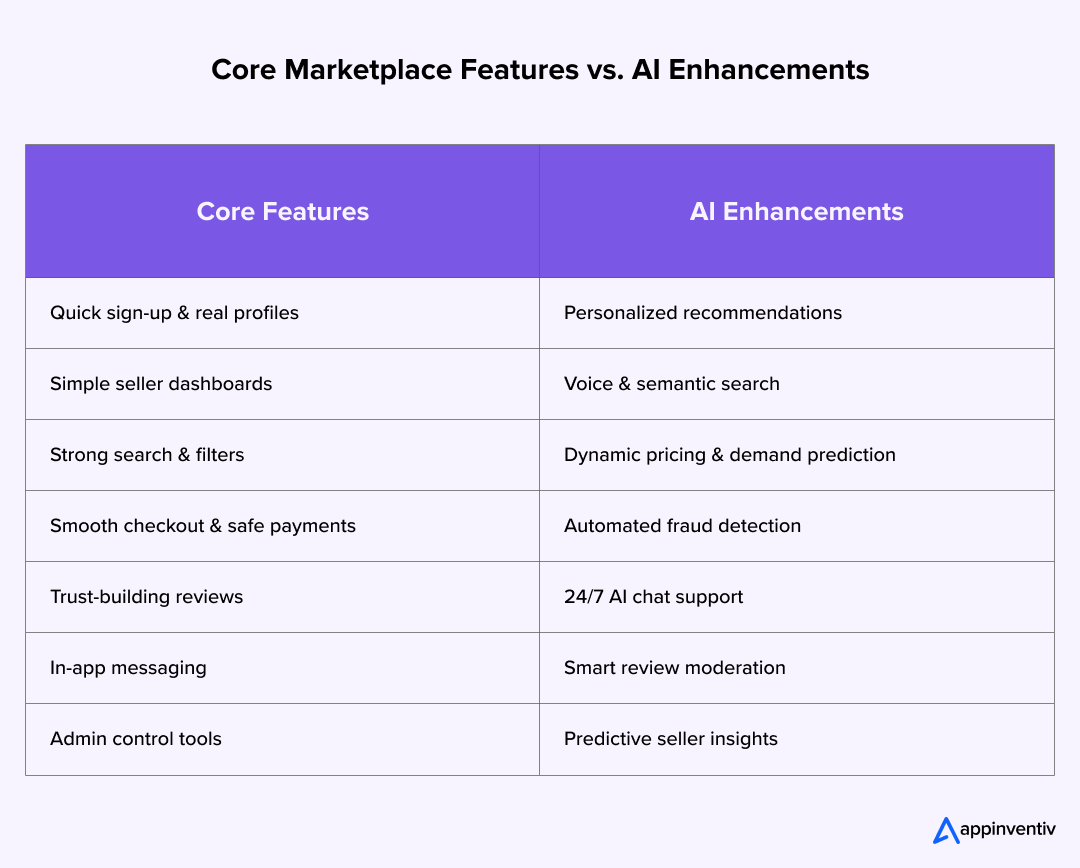
Must-Have Marketplace Features
- User onboarding and profiles
Make sign up quick and clear. Email, phone or social login all work. Check just enough to build trust but keep it simple. Profiles should look real with names, photos and short bios. Add badges or credentials if they build confidence. - Seller dashboards and listings
Give sellers a clean workspace. They should be able to upload photos, write descriptions, set prices and see basic performance stats like how many times an item was viewed. Small signals help them stay active. - Search and filtering
Help buyers find what they want fast. Offer strong search and useful filters such as price, location, rating or delivery time. Add niche filters that make sense for your category, like skill level for freelancers or size for rentals. - Cart, checkout and payments
Keep buying smooth and safe. Show total cost early, give multiple payment options and handle taxes or fees clearly. Store payment details safely for repeat buyers but let them control what stays saved. - Reviews and ratings
Real feedback builds trust. Verified purchase tags, clear photos and short video reviews make ratings more believable and helpful. - Messaging between users
Keep conversations inside the platform. It is safer for users and gives you data to make trust features better. Quick notifications help deals move faster. - Admin console for moderation
You need tools to watch platform activity, spot problems early and help users when something goes wrong. Good moderation keeps the community safe without being visible.
AI-Powered Enhancements
Once the basics are in place, AI is what makes a marketplace feel alive instead of just functional. If you plan to build an AI marketplace app, think through those first steps early. It will help you choose what to launch right away and what can wait. The goal is simple, take out friction and make things easy for buyers and sellers.
- Personalized recommendations: Show people what they are likely to want next. AI can study searches, past purchases and browsing habits to surface things that match their taste. When it works well, it feels like quiet help from someone who knows you, not another ad fighting for attention.
- Semantic and voice search: Let people search the way they normally talk. Someone might type “freelance video editor for wedding highlights” or just ask aloud while busy. AI powered semantic search figures out meaning, not just words, and brings back useful results.
- Dynamic pricing and demand prediction: Help sellers price with confidence instead of guessing. AI can follow demand changes, compare competitor pricing and notice seasonal shifts. Predictive analytics in AI marketplace platforms give sellers a fair edge and help buyers trust the price.
- Automated fraud detection: Keep the space safe from the start. AI can flag fake accounts, suspicious reviews and chargeback fraud faster than any manual review. The safer people feel, the more likely they are to return.
- AI chatbots for 24/7 support: Questions will always come up, whether they’re about returns, payments, listings or delivery. AI chatbots can handle routine ones right away and hand off tougher issues to humans so no one gets stuck waiting. It is one of the easiest ways to bring AI integration into marketplace apps.
- Smart review moderation: AI can help clean up spam, offensive language and fake profiles. The result is a space where users trust reviews and you do not need a huge support team to keep it that way.
- Predictive seller performance insights: Give sellers a clear picture of how they are doing. AI can flag slow response times, suggest better listing titles and even warn about demand spikes so stock is ready when needed.
When you combine these pieces, you get a marketplace app with AI features that feels helpful, safe and personal. It will become a place people want to use again.
Start Lean but Create an “Aha Moment”
Choosing one impactful AI feature early also helps you see the real value of AI in marketplace apps before investing in more complex systems. Do not try to build every feature at once. Launch with the core marketplace essentials and add one or two high-impact AI features that instantly feel different. It might be personalized recommendations that surprise buyers with spot-on suggestions or fraud detection that gives sellers peace of mind. That one smart experience can hook users early and become part of your story- “this app just gets me” or “this platform feels safe.”
Let’s build your AI marketplace app together.
Phases of AI Marketplace App Development
Deciding to build an AI-powered marketplace app is a real investment and requires understanding what drives cost in AI marketplace app development. It’s a series of small, smart moves that help you test fast, cut risk, and ship something people actually want to use.
Each stage matters because skipping one usually shows up later as costly fixes. If this is your first time working with AI in products, you might find this practical guide on building an AI app helpful before diving into marketplace-specific planning.
Planning & Requirements
This is where you pause and make sure everyone is looking in the same direction. Start by writing out simple user stories. Think through what a buyer should be able to do from sign-up to checkout and what a seller needs to list products and get paid. Note which features cannot wait and which ones can be added later. Decide how you will track success: maybe the number of sign-ups that become active users, how often people complete transactions, or how accurate recommendations should feel.
Clear user stories and KPIs help stop scope creep before it starts. They give marketplace app development with AI a clear path and keep every new feature tied to real user needs.
UX/UI Prototyping
Next, make the idea real without touching code. Sketch screens, build clickable mock-ups, and show how the AI shows up in the experience. Where will recommendations appear? Will chatbots be obvious or tucked away? How will price tips surface for sellers? Share these early designs with a few potential users. Watching them click through is often the fastest way to catch confusion before it’s expensive to fix.
Model Development & Integration
Here’s where the AI work begins. Start simple if you can. Use pre-trained models for recommendations or search to move quickly. As your own data grows, you can shift to custom or fine-tuned models to get better results. Set up ways for the models to plug into your live app and respond instantly when someone searches or shops.
Plan ahead for retraining so the AI keeps learning rather than going stale. These careful choices shape the AI marketplace development process, making sure your models remain effective and trustworthy as the platform scales.
Backend and Frontend Development
Build the parts that make your marketplace work and the parts people will see. The backend keeps things running — user accounts, listings, payments, and the processes behind them. The frontend is what buyers and sellers click through, so keep it clear and easy.
Think about AI while you plan. If you want smart search, chat help, or product suggestions, design for them now instead of adding them later. It will save you time and make the experience feel natural.
QA & Testing
Before launch, push the product as hard as you can. Check if payments go through without trouble, if the app stays fast when traffic spikes, and if search shows useful results. This step is one of the most important in the AI marketplace app development process because it proves the platform is reliable before real users arrive.
Rigorous testing also helps reveal the challenges of building an AI marketplace app early. Watch for biased recommendations or unexpected slowdowns before customers see them. Test the AI features too. Are the suggestions accurate? Are fraud alerts catching real issues? Look closely for anything that could feel unfair or break trust. It is far better to fix problems now than risk losing early users.
Deployment & Monitoring
Do not drop everything live at once. Roll out to a small group first. Careful rollout and observation are also part of the core steps to build an AI marketplace app. This helps in keeping early issues from scaling into bigger problems.
Track speed, errors, and how users react to AI features. Set up alerts so if something fails — like slow responses or broken suggestions — you know quickly and can fix it before more users hit the same issue.
Post-Launch Improvement
Once your app is live, keep improving. Feed new data back into your models to make them smarter. Watch where users drop off or what features they love. Fine-tune onboarding, search, and recommendations to keep people engaged. A strong marketplace is always learning.
This cycle of updates and learning is a key part of the AI marketplace development process, helping the app stay competitive and useful.
Understanding Cost and Timelines of AI Marketplace App Development
Understanding cost drivers early helps founders plan resources and avoid delays when they set out to build an AI marketplace platform with intelligent features. Building an AI-powered marketplace is a real investment.
The price tag depends on how ambitious you are and how much intelligence you want in version one. Getting clear on these numbers early helps you plan funding, talk to partners, and avoid ugly surprises later.
What Drives the Cost
The cost of AI-powered online marketplace app development is never the same for everyone. It really depends on how big your idea is and how much intelligence you want built in from day one. Instead of thinking about a fixed price, picture a range that shifts as you make choices along the way.
- AI model complexity: You can move faster and keep costs lower if you start with ready-made AI models for things like recommendations or fraud checks. But if your app needs something very specific — say, fraud detection that can spot unusual buying patterns or pricing that reacts to market changes — you will need custom models trained on your own data. That takes more time, skill, and money, but it can give your platform an edge.
- Data preparation: AI is only as good as the data behind it. Collecting, cleaning, and organizing data can take weeks or months because real people often need to label or check it. Many skip this step and pay for it later with poor recommendations and unexpected fixes. Doing the groundwork now saves frustration and future costs.
- Feature scope and integrations: Keeping the first release simple is a smart way to control spending. Each new feature adds work — think advanced filters, built-in chat, multiple payment gateways, shipping tools, or ID checks. Add too many at once and the budget rises quickly.
- Team size and skill level: A small, generalist team might handle a basic app. But if you want something polished and reliable with smart AI, you’ll need machine learning engineers, data scientists, and experienced cloud developers. Their skills cost more but reduce mistakes and rebuilds later.
- Infrastructure and compliance: AI needs strong computing power to run well. As more people join, your hosting and processing bills will go up. If your app handles personal data, rules like GDPR also add work to keep everything private and safe.
Typical Cost Ranges
Most founders see numbers like these:
- An MVP with basic AI features often costs $40,000 to $160,000 USD.
- More advanced apps with custom AI and multiple models usually land between $160,000 and $400,000 USD or more.
- Build time is usually four to nine months, depending on complexity and team speed.
These ranges give a practical view of the cost to develop an AI-powered marketplace app so you can match scope with your budget.
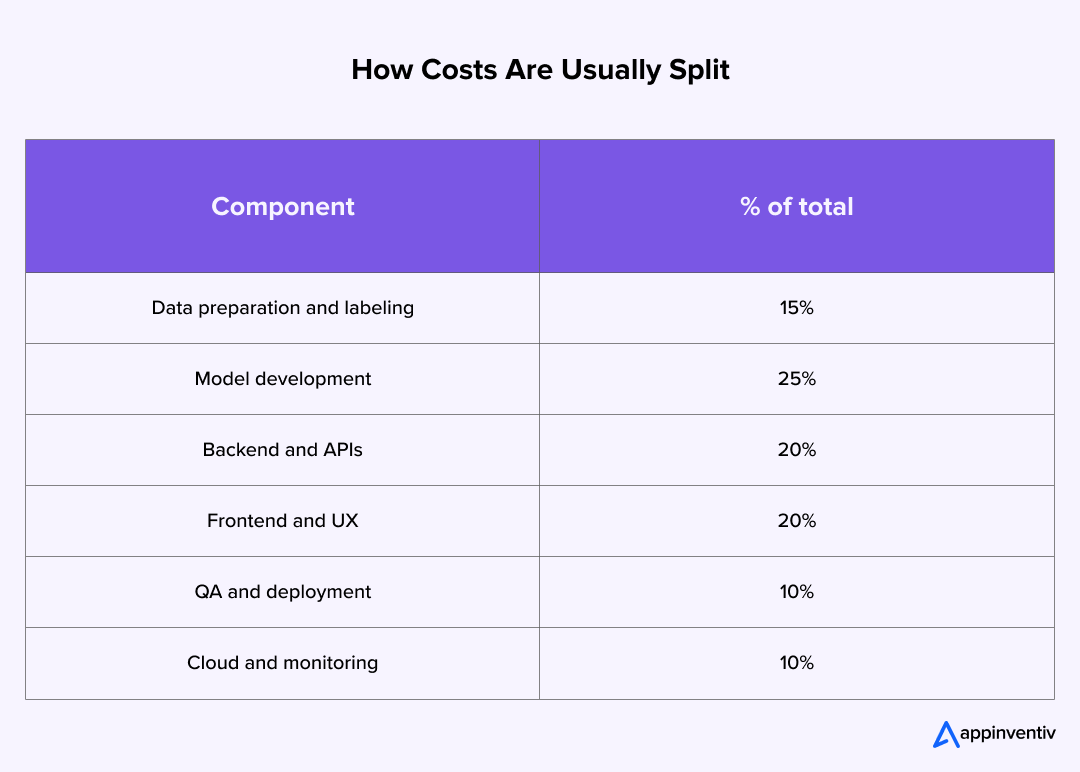
This breakdown is a helpful starting point but will shift if you choose to build more custom AI models or integrate advanced features early.
Plan for Ongoing Spending
Launching is not the end. AI needs care to stay accurate and useful. Plan for:
- Compute and host as your traffic grows.
- Model retraining to keep recommendations and fraud checks sharp.
- Feature improvements based on real user feedback.
- Support and security updates to handle bugs and protect data.
Continuous on-demand marketplace AI integration should be part of this long-term plan. Factoring in long-term support ensures your AI-based marketplace solutions stay reliable, accurate, and competitive as usage scales. Budgeting for this from the start keeps the app healthy and prevents sudden, painful bills later.
Go-to-Market & Growth Tactics
Growth is a major factor to consider during AI-powered marketplace app development because how you attract the first users shapes future retention. Getting the app built is only the first half of the job. Now you need people to use it. This is the hard part most marketplaces struggle with because you have to break the empty room problem and build momentum.
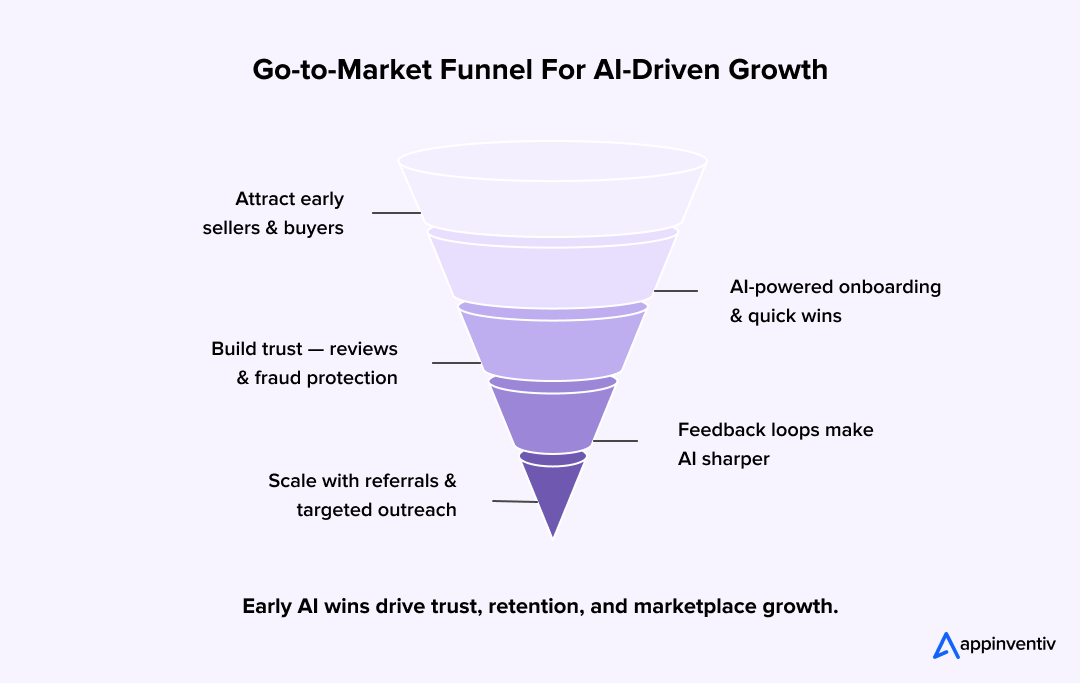
Early Liquidity
Start small. Pick one group to win over first, buyers or sellers, and focus there. If you bring in sellers early, give them a reason to show up — lower fees for the first months, extra space in search results, or credits they can spend later. If you decide to start with buyers, make joining feel rewarding with discounts, credits, or perks for inviting friends.
The aim is simple: make those first few transactions happen fast so the platform does not feel empty. Deloitte reports that retailers using generative AI to power search and personalization saw conversion rates climb by up to 15% during peak shopping seasons. It’s a clear sign that early AI wins can spark momentum and build user trust.
AI-Powered Onboarding
Make joining feel rewarding. When someone signs up, help them see value right away. If it is a buyer, show listings or matches that fit what they are searching for. If it is a seller, guide them to create a strong listing and suggest prices that make sense. Getting them a quick win builds trust and gives them a reason to return.
Feedback Loops
Watch how people really use your marketplace. What do they search for first? Where do they click? Where do they give up and leave? Use what you see to fix small things, for example offer better search results, clearer pricing, smarter suggestions.
You can also ask for tiny signals, like a “Was this useful?” tap or a thumbs-up. Over time, these bits of feedback help the platform feel more personal and easy to use. The same data will shape future AI-driven platform development for marketplaces, so your recommendations and pricing keep getting better as more people join.
Positioning and Storytelling
Be clear about what you’re building and why it matters. This isn’t just another place to post stuff. You’re making a marketplace that feels smarter and safer to use. Talk about real things happening inside it — a new seller closing their first sale, a buyer finally finding what they needed after searching everywhere else. Stories like these connect with people better than any tagline.
At the start, go where your first users already are. That could be small online groups, niche forums, or focused social ads. Big campaigns can wait. Sharing real wins early builds trust and shows the true benefits of an AI marketplace app. Clear messaging now also sets up your AI-driven marketplace platform for businesses to keep growing long after the first users join.
Challenges and Best Practices for AI Marketplace Apps
Launching an online marketplace sounds exciting, but reality hits fast. Getting the first few users is harder than it looks. Adding AI on top of that can feel like you’re building two products at once — the marketplace itself and the intelligence behind it. But if you know the challenges of building an AI marketplace app before you dive in, you can plan smarter, move faster, and avoid mistakes that burn time and money. You’ll also be better positioned to show the real benefits of an AI marketplace app once people start using it.
| Challenge | Solution/Best Practices |
|---|---|
| Cold Start ProblemEmpty platform, no trust, no data for AI. | Seed activity early. Invite niche sellers, curate initial listings, offer small rewards to trigger real transactions. |
| Bias in AI ModelsEarly, narrow data makes unfair or irrelevant suggestions. | Diversify data early. Onboard sellers from different categories and regions. Review and adjust AI outputs. |
| Data Privacy ConcernsUsers hesitate to share information. | Be transparent & simple. Explain why data is needed, keep it minimal, encrypt and give easy control to users. |
| Rising AI & Infra CostsCompute and hosting bills grow silently. | Scale smart. Start with essential AI features, monitor usage, adopt flexible hosting and expand as data proves ROI. |
Cold Start Problem
Every marketplace starts the same way: empty. There’s no activity, no trust, no data for your AI to work with. Buyers see blank pages, and sellers hesitate because they don’t want to waste time on a platform that looks dead.
The Solution: Focus on a very small but meaningful first group. Reach out to sellers yourself, help them set up strong listings with great photos and clear pricing. If you need to, add a few curated products so buyers don’t land on an empty feed. Offer simple rewards — a discount, credits, maybe an early badge — to get real transactions moving. As soon as deals start happening, the AI has something to learn from, and the platform begins to feel alive.
Bias in AI Models
AI will echo the data you feed it. If your early users all come from one place or sell the same type of thing, the system can start making unfair or irrelevant suggestions. That frustrates buyers and can scare off good sellers.
The Solution: Mix it up from day one. Invite sellers from different regions and product categories. Watch how the AI responds and step in to review early recommendations yourself. Adjust or retrain when you see odd results. Over time, this keeps the system fair and makes personalization feel smart and trustworthy, which is one of the biggest benefits of an AI marketplace app.
Data Privacy Concerns
AI runs on data, but asking people to share information is tricky. Even if you follow GDPR or CCPA, complicated privacy rules can confuse users and make them hesitate.
The Solution: Be direct and human about privacy. Explain what you collect and why it helps — faster search, safer deals, better matches. Only ask for what you really need, protect it well, and give users easy ways to check or delete their details. Clear privacy practices turn doubt into trust and help position your product as a safe AI-driven marketplace platform for businesses.
Rising AI and Infrastructure Costs
AI isn’t cheap to run. Every recommendation, every fraud check, every instant search burns computing power. Costs can climb quietly until they hit you all at once.
The Solution: Grow slowly and with intention. Start with the AI features that add obvious value. Use flexible hosting so you only pay for what’s used. Track costs early instead of waiting for a surprise bill. Hold off on complex custom models until the data proves they’re worth it. Careful planning keeps your AI-driven marketplace platform for businesses profitable while still smart enough to impress users.
Launch an AI-driven marketplace app that adapts and scales with its users
Why Partnering with Appinventiv Accelerates Your AI Marketplace Vision
Building an AI-powered marketplace app is not just writing code. It is about connecting data, machine learning, design, privacy, and growth strategy in one clear plan — and getting it to market fast enough to stay competitive. That is where Appinventiv can help.
We have worked with startups and global brands to build AI-powered marketplace apps and guide them through every stage of AI-powered marketplace app development, from idea to launch. Our experience spans retail, healthcare, and B2B SaaS, so we understand how to shape AI for different industries and user needs.
Here is how we help:
- Deep AI expertise
Our team handles the entire AI journey. We prepare and organize data, train and fine-tune models, and integrate them into the product so features like recommendations, fraud detection, and pricing guidance work smoothly. This is where our AI development services stand out. - Full product development under one roof
We plan, design, build, and scale — strategy, UX, backend, mobile and web apps, cloud, and DevOps. Having one team handle everything keeps AI-powered marketplace app development faster and avoids gaps between idea and execution. - Security and compliance from the start
We build with trust in mind. Privacy and safety are part of the core architecture. Whether your app needs to meet GDPR, HIPAA, or PCI, we design for it early so users can feel safe and you avoid legal risk. - Growth and long-term support
Our AI consulting services also help plan adoption strategies and optimize the results of your AI marketplace app development after launch. That means your platform is ready not just to launch but to grow steadily.
One example is the Adidas eCommerce app we helped build for the Middle East. The project included localization, multi-currency support, smooth UX, and fast, reliable performance. That type of end-to-end delivery is possible when one experienced team builds everything from the foundation to the AI-driven features.
If you want to move past generic marketplace apps and launch something smart, adaptive, and future ready, Appinventiv can help you validate your idea, design AI-first workflows, and build a platform that stands out.
FAQs
Q. How do I build an AI-powered marketplace app for my business?
A. If you want to build an AI-powered marketplace app, start with the real problem you want to solve. Picture the people who will use it. What slows them down now? Buyers might spend hours searching and still not find what they need. Sellers might struggle to build trust or show credibility. Write down the must-have features first: sign up, product pages, payments, reviews. Then step back and see where AI can make things better. Maybe faster search, safer transactions or smarter matching.
AI only works if the data behind it is clean. Plan early what you will collect and how to keep it accurate. If the technical side starts to feel overwhelming, it is often faster and safer to work with a team that has already built marketplace apps successfully.
Q. How can Appinventiv help develop AI-driven marketplace applications?
A. We have built new marketplaces from the ground up and helped established ones scale. Usually the work starts with shaping the core idea and mapping user flows. Only after that do we bring in AI. Search that feels intelligent, recommendations that actually make sense, fraud checks that protect without making things harder for real users. We also plan ahead for growth and compliance so your app does not stall as it gets bigger.
Q. What features should an AI marketplace app include?
A. Keep the first version lean. Make sign up easy. Give sellers a dashboard they can figure out fast. Build search and filters that work well from day one. Keep payments smooth and safe. Make reviews clear and credible.
Once that is running, add AI that helps in obvious ways. Personal suggestions, intent based search, early fraud alerts, price tips, quick chatbots and insights for sellers to improve what they offer.
Q. How much does it cost to develop an AI marketplace app?
A. There is no single price. A smaller build with light AI might cost $40k to $160k. Bigger custom projects can go past $400k. Timelines often run four to nine months. Remember AI is not finished at launch. You will need to train and update models as more people use the app.
Q. How can AI improve the functionality of a marketplace app?
A. It speeds things up and makes the platform safer. Buyers find what they want faster. Sellers understand what is trending and how to price better. Fraud gets flagged before it spreads. Chatbots handle quick questions so users do not wait for help. Over time the system learns and becomes more personal.
Q. How do I add AI to an existing marketplace?
A. Start small and practical. Review the data you already have such as searches, purchases and reviews. Pick one area where AI can have an immediate impact like better recommendations or fraud detection. Use ready models first then go custom once your data is strong. If scaling or privacy worries you, working with experienced AI engineers helps keep the system stable.


- In just 2 mins you will get a response
- Your idea is 100% protected by our Non Disclosure Agreement.

How Much Does It Cost to Build an AI App in Dubai?
Key takeaways: AI app costs in Dubai typically range from AED 80,000 for simple builds to AED 800,000+ for enterprise systems. Dubai is past AI experimentation, and not investing now means catching up later at higher cost. The real budget is driven by data, integrations, architecture, and compliance, not just app features. Hidden costs like…
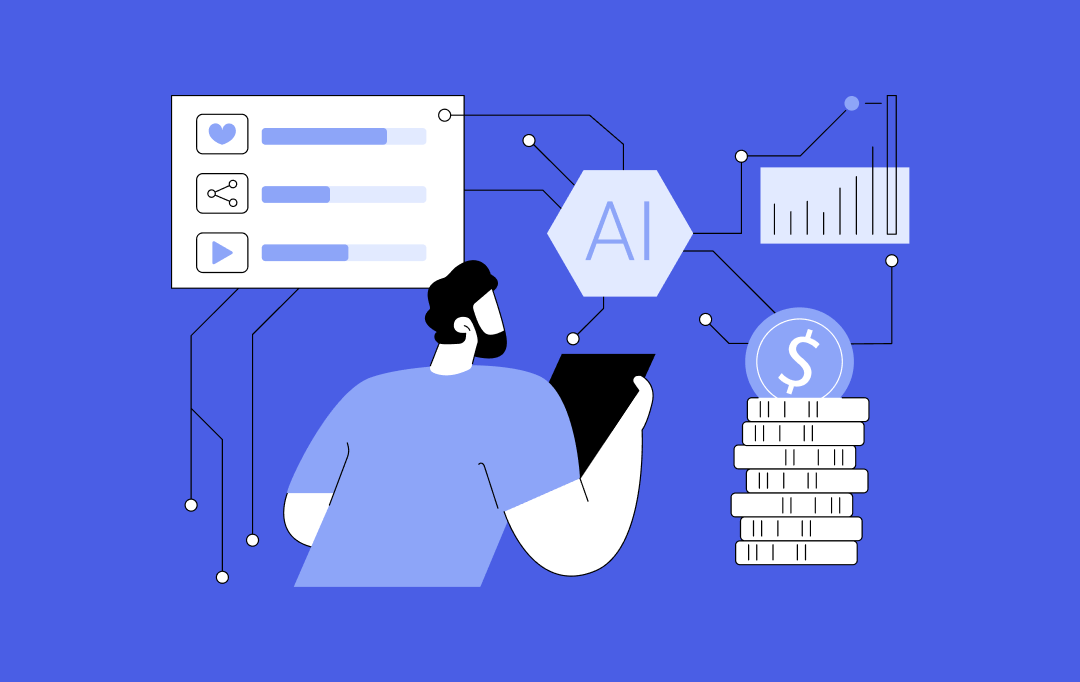
How AI Tokenization is Enabling Secure and Transparent Asset Ownership in 2026
By 2026, AI tokenization has moved beyond early-stage experiments and pilot projects. Tokenizing real-world assets has become a serious commercial strategy for financial institutions, supply chain operators and technology-driven enterprises. A 2025 report by the World Economic Forum in collaboration with Accenture highlights tokenization as a key mechanism for value exchange in modern financial markets.…

13 Ways Generative AI is Transforming the Hospitality Industry
Key takeaways: The most mature applications of Generative AI for hospitality are in guest service, revenue management, marketing, and operations automation. Real value comes from integrating generative AI into hospitality operations and existing PMS, CRS, CRM, and POS systems, rather than using stand-alone tools. Successful programs treat Generative AI in hospitality as a product, incorporating…











